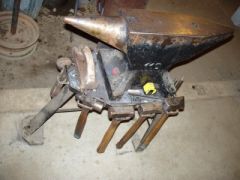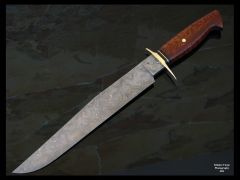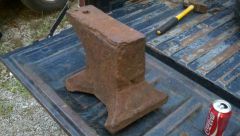
Dave English
Members-
Posts
59 -
Joined
-
Last visited
Profile Information
-
Gender
Not Telling
Converted
-
Location
Oceanside, California
-
Biography
I'm 64and have been learning blacksmithing for two years. I have a Hay Budden anvil, other tools.
-
Interests
Blacksmithing, studying, meteor observations, prospecting, writing.
-
Occupation
Simi-retired
-
-
-
-
- 8 comments
-
- Bowie Knife
- Knifemaking
-
(and 3 more)
Tagged with:
-
Experimentation is great but keep good records. You should try and find out the carbon content of your steel as all that you do should be baised on that.
-
-
RR track is heavy, I wanted a 5 foot section that had been dumped in the creek but couldn't climb out of the steep creekbed with it, something about mass and traction.
-
I like it. Looks hand made which is what folks should want to buy.
-
Great little shop, I like all the stuff hanging on the outside too in the photo you are in. For some reason I seem to like hanging things(?), like chains, tools, plants, ironworks.
-
I made a snail yesterday just goofing around waiting for some kids to show for a talk about blacksmithing. Never got the eyes on but next time I get around a forge, I'll try and tack weld them on. You have to fold the shoe in in the middle to get the tail. Brian and his brother are held in high regard in the California Blacksmith Association, nobody should feel bad when comparing their own art to to them, they rank with the best artist blacksmiths today.
-
Any Experiance With Scrap Ingot Iron
Dave English replied to Dave English's topic in Blacksmithing, General Discussion
I had posted how the core of transformers can be steel, air or pure iron, dependingon thier use. The Navy uses steel in plates for the most part so scrap Navy transformers should have steel cores. Iron cores can be found on -20 KHz, smaller tranformers, but I don't know if a smaller transformer is 2 pounds or 200 pounds. -
Any Experiance With Scrap Ingot Iron
Dave English replied to Dave English's topic in Blacksmithing, General Discussion
I just spent about 20 min writing a detailed reply and was told I had to log in (I was already logged in) and as you may have experianced yourself, the reply was lost in cyber space never to be seen again. This is about the 6th time this has happened, I should have 48-49 posts, not 42. My best posts are ...... -
Anything less than 100% cotton won't do. I thought my shirt was 100% cotton but it was some mix of cotton and synthetic. I discovered my error during a forge welding exercise, I ended up with a little bit of shirt "forge welded " to my skin. Removing the pinhead sized "weld" was painful and a good lesson to be more careful with what I select to wear.
-
Any Experiance With Scrap Ingot Iron
Dave English replied to Dave English's topic in Blacksmithing, General Discussion
This is very pure iron, not steel, such as Armco ingot iron of the American Rolling Mills Co in 1956, is 99.94% pure iron. I don't know if transformer cores are the same but I believe it would be of some type of pure iron. The reason I ask is that iron cores in scrap large electric motors and generators may be worth locating if the the iron forge welds like wrought iron. -
In my Materials Handbook, 1956, is a description of ingot iron that's used for special purposes, electromagnetic cores, boiler plate, for water tanks. It often has very low carbon, .02%, but can be as high as .15%, it's rust resistent. How does this weld? Is it like wrought iron where the two pieces actually are welded together or is it more like or mild steel where it's more of a surface weld?


